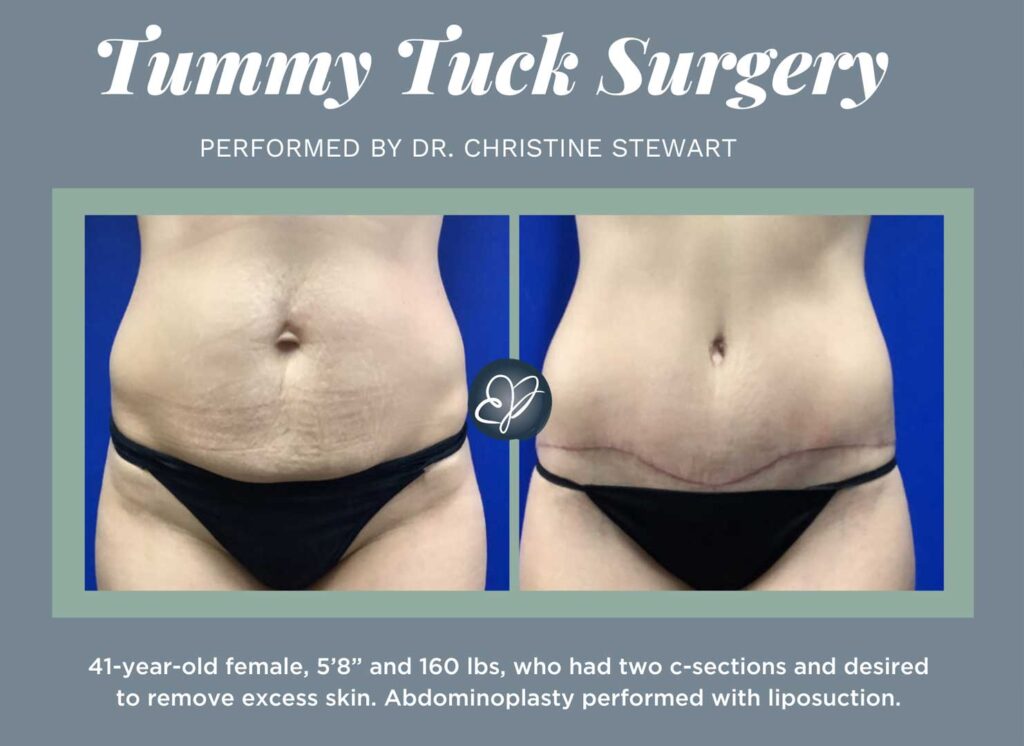Tummy tuck surgery can completely transform a patient’s abdomen, making it flatter, smoother, and more defined. But few patients consider a small anatomical feature that can greatly impact their overall satisfaction with their final outcome. How natural your belly button appears after abdominoplasty surgery can influence your satisfaction with your end result. Here’s why such a small feature of our body can profoundly affect the success of tummy tuck surgery.

Why is the Belly Button such a Big Deal in Tummy Tuck Surgery?
“How your plastic surgeon manages your belly button during tummy tuck surgery is critical,” explains Dr. Christine Stewart, a board-certified plastic surgeon and partner with Edina Plastic Surgery. “Achieving a perfect-looking belly button may not be possible with each surgery, but there are measures we can take before, during, and after your tummy tuck surgery to ensure the most natural-looking outcome.”
What Happens to Your Belly Button During Abdominoplasty?
A tummy tuck is not a one-size-fits-all surgery. In addition to making micro-adjustments to your abdominoplasty depending on your anatomy, three typical tummy tuck options are available based on a patient’s needs: a standard, extended, or mini tummy tuck. Most patients benefit from a standard tummy tuck, which can effectively address a significant amount of skin sagging in the upper and lower abdomen, muscle separation, and residual fat deposits. People experiencing extreme amounts of sagging skin (usually following massive weight loss or higher impact pregnancy) will likely benefit more from an extended tummy tuck procedure. A mini tummy tuck is reserved for patients with minimal, mostly in the lower abdomen, and whose belly button resides in a naturally high anatomical location because the mini tummy tuck will reposition the location of the umbilicus to a slightly lower position.
“How your plastic surgeon approaches your belly button during a tummy tuck depends entirely on your physique,” says Dr. Stewart. “In general, we no longer completely remove the umbilicus during surgery, which resulted in many abnormal-looking belly buttons in the past. But removal is sometimes unavoidable, especially if a patient has a belly button with an unusual positioning or shape, or if scarring or an extreme amount of excess skin is present.”
“Your plastic surgeon will go with one of two belly button options during most tummy tuck surgeries,” explains Dr. Stewart. “The first method keeps the umbilical stalk intact. The stalk is comprised of the tissues that create your belly button. One end of the stalk is tethered to your abdominal wall, and the other end is the ‘button’ of your belly button. Your surgeon will remove all excess skin around the belly button and abdomen. They will then pull down the skin from the mid and upper abdomen to create a new opening for the belly button to be placed within. How much of the stalk that is kept and how the surgeon creates the new opening is highly variable from surgeon to surgeon.”
“Umbilical float is the other belly button option used only during mini tummy tuck surgery,” says Dr. Stewart. “This method is used when the belly button needs to be relocated, usually because a patient has little excess skin in their upper abdomen but a moderate amount in the lower abdomen. The umbilical float technique also allows repair of rectus diastasis, or muscle separation. In an umbilical float, the umbilical stalk is detached from abdominal wall, repositioned lower on the abdomen while still intact with the surrounding skin, and reconnected to the abdominal wall.”
What Factors Lead to an Abnormal-Looking Belly Button after Tummy Tuck Surgery?
“There are a lot of variations of belly button aesthetics in the human population, but there is a defined “ideal” umbilicus,” explains Dr. Stewart. “This is an umbilicus that is small, oval, concave, with superior hooding and somewhat tubular configuration. The location of the umbilicus is almost always off midline in all of the population, something that is not often noticed until an abdominoplasty. The height of the belly button, ideally is in line with the hip bones or slightly above. With a standard abdominoplasty or extended abdominoplasty, the location of the belly button will not change. The scar location for the abdominoplasty will also visually inform where the umbilicus seems to sit on the abdominal wall. An abdominoplasty scar should be placed low, usually about 6 cm from the vulvar commissure (where the mons pubis meets the lips of the labia majora). The location of an abdominoplasty scar can vary surgeon to surgeon and can vary person to person depending on the person’s anatomy.”
Two factors generally contribute to an unnatural-looking belly button after abdominoplasty surgery. The first is if the original shape or condition of the belly button was abnormal, to begin with. The second is if the ‘button hole’ a plastic surgeon creates to slide the belly button into is unnatural. It’s important to note that belly button abnormalities naturally exist before surgery and may never be noticed due to excess skin hiding them.
A mini abdominoplasty with umbilical float should only be performed if a patient has a higher than normal umbilicus. Otherwise once the belly button is repositined, it will appear too low.

What Factors Lead to a Natural-Looking Belly Button After Tummy Tuck Surgery?
You must seek out a licensed, board-certified, and experienced plastic surgeon to ensure the safest and best results from tummy tuck surgery. During your initial consult, ask your plastic surgeon to see pictures of the tummy tucks they have performed and articulate what you like or don’t like about the belly buttons you see. This step will help set realistic expectations for your surgery that balance your desired aesthetic and what is achievable with your unique anatomy.
Can My Recovery After Tummy Tuck Affect the Final Appearance of My Belly Button?
YES! Your tummy tuck recovery can influence how your belly button heals and appears after surgery. It is essential that you follow your surgeon’s post-care instructions and recovery protocol after surgery.
“Abdominoplasty is a major surgery whose recovery should not be taken lightly,” stresses Dr. Stewart. “Lifting things that are too heavy or straining your abdominal muscles too soon after surgery can have significant consequences for your final outcome. Follow your post-care instructions to the letter. Adhere to all instructions regarding incision care, silicone gels, healing ointments, and compression garments. Prioritize rest and healing! The more compliant you are with post-care, the better your end result will be, and the faster you’ll be able to enjoy your flatter, smoother midsection!”
Have you been considering tummy tuck surgery? Schedule a complimentary consultation to discuss this surgery with Dr. Christine Stewart or another board-certified plastic surgeon at Edina Plastic Surgery by calling (612) 688-3181, texting (952) 925-1765, or CLICKING HERE!


